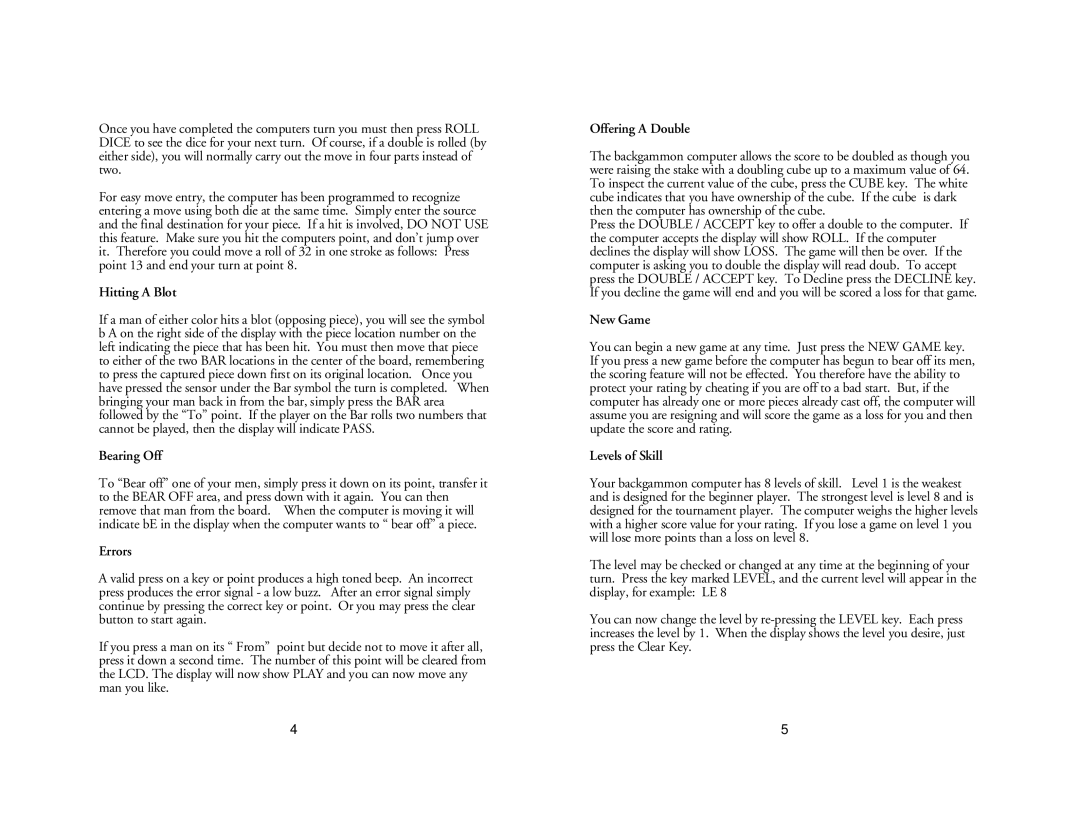Once you have completed the computers turn you must then press ROLL DICE to see the dice for your next turn. Of course, if a double is rolled (by either side), you will normally carry out the move in four parts instead of two.
For easy move entry, the computer has been programmed to recognize entering a move using both die at the same time. Simply enter the source and the final destination for your piece. If a hit is involved, DO NOT USE this feature. Make sure you hit the computers point, and don’t jump over it. Therefore you could move a roll of 32 in one stroke as follows: Press point 13 and end your turn at point 8.
Hitting A Blot
If a man of either color hits a blot (opposing piece), you will see the symbol b A on the right side of the display with the piece location number on the left indicating the piece that has been hit. You must then move that piece to either of the two BAR locations in the center of the board, remembering to press the captured piece down first on its original location. Once you have pressed the sensor under the Bar symbol the turn is completed. When bringing your man back in from the bar, simply press the BAR area followed by the “To” point. If the player on the Bar rolls two numbers that cannot be played, then the display will indicate PASS.
Bearing Off
To “Bear off” one of your men, simply press it down on its point, transfer it to the BEAR OFF area, and press down with it again. You can then remove that man from the board. When the computer is moving it will indicate bE in the display when the computer wants to “ bear off” a piece.
Errors
A valid press on a key or point produces a high toned beep. An incorrect press produces the error signal - a low buzz. After an error signal simply continue by pressing the correct key or point. Or you may press the clear button to start again.
If you press a man on its “ From” point but decide not to move it after all, press it down a second time. The number of this point will be cleared from the LCD. The display will now show PLAY and you can now move any man you like.
Offering A Double
The backgammon computer allows the score to be doubled as though you were raising the stake with a doubling cube up to a maximum value of 64. To inspect the current value of the cube, press the CUBE key. The white cube indicates that you have ownership of the cube. If the cube is dark then the computer has ownership of the cube.
Press the DOUBLE / ACCEPT key to offer a double to the computer. If the computer accepts the display will show ROLL. If the computer declines the display will show LOSS. The game will then be over. If the computer is asking you to double the display will read doub. To accept press the DOUBLE / ACCEPT key. To Decline press the DECLINE key. If you decline the game will end and you will be scored a loss for that game.
New Game
You can begin a new game at any time. Just press the NEW GAME key. If you press a new game before the computer has begun to bear off its men, the scoring feature will not be effected. You therefore have the ability to protect your rating by cheating if you are off to a bad start. But, if the computer has already one or more pieces already cast off, the computer will assume you are resigning and will score the game as a loss for you and then update the score and rating.
Levels of Skill
Your backgammon computer has 8 levels of skill. Level 1 is the weakest and is designed for the beginner player. The strongest level is level 8 and is designed for the tournament player. The computer weighs the higher levels with a higher score value for your rating. If you lose a game on level 1 you will lose more points than a loss on level 8.
The level may be checked or changed at any time at the beginning of your turn. Press the key marked LEVEL, and the current level will appear in the display, for example: LE 8
You can now change the level by
4 | 5 |
